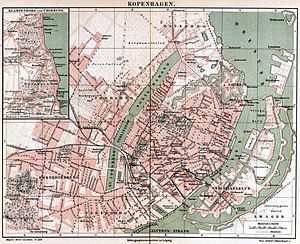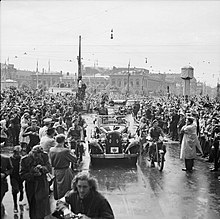History of Copenhagen
The town was significantly enlarged under Christian IV of Denmark after his coronation in 1596 by the addition of new city districts and modern fortifications with earthworks and bastions.
By the time of Christian IV's death in 1648, Copenhagen had become Denmark's principal fortification and naval port, and the town formed a framework for the administration of the Danish kingdom and as a centre of trade in Northern Europe.
It was during this battle Lord Nelson "put the telescope to the blind eye" in order not to see Admiral Parker's signal to cease fire.
When a British expeditionary force bombarded Copenhagen in 1807 in order to take control of the Danish navy, thus denying it to nascent French plans to invade Britain, the city suffered great damage and hundreds of people were killed.
The main reason for the extensive devastation was that Copenhagen relied on an old defence line rendered virtually useless by the long ranged bombard ships and mortar batteries employed by the British.
[5] Details of the existence of a small town as early as the 11th century have recently been published by Videnskab.dk with a series of articles documenting new archeological finds.
These provide evidence of a large estate at today's Kongens Nytorv, a church close to the later St Clemens, a market, at least two wells and many smaller habitations spread over a fairly wide area.
The Roman Catholic Church erected cathedrals in Roskilde and in Lund (in what is now Sweden), which laid the basis for further development in those regional centres.
The earliest written mention of the town dates back to the 12th century, when Saxo Grammaticus in Gesta Danorum refers to it as Portus Mercatorum, which translates into Merchants' Harbour or in the Danish of the time Købmannahavn.
Copenhagen is located at the most important approach to the Baltic Sea and the rich North German trading towns of the Hanseatic League, providing it with power and wealth but also threatening its very existence.
Apart from the new earthworks Christian IV commissioned German and Dutch architects and craftsmen to construct magnificent edifices designed to enhance his prestige.
By the time of Christian IV's death in 1648, Copenhagen had become Denmark's principal fortification and naval port, and the town formed a framework for the administration of the Danish kingdom and as a centre of trade in Northern Europe.
[18][20][21][22] It was during this battle that Lord Nelson famously "put the telescope to the blind eye" in order not to see Admiral Parker's signal to cease fire.
Roughly at the same time the ramparts of the city opened to allow new housing to be built around the lakes ("Søerne") which bordered the old defence system to the west.
As the area within the ramparts had been almost constant since the reign of Christian IV despite a fourfold increase in the population, the buildings had become taller and the amount of space available to residents had decreased.
A new neighbourhood arose in 1861–77 on the island of Gammelholm as Holmen Naval Base was moved to Nyholm, and large parts of Nyboder were changed into ordinary residences.
In August 1943, when the government's collaboration with the occupation forces collapsed, several ships were sunk in Copenhagen Harbour by the Royal Danish Navy to prevent them being used by the Germans.
Operation Carthage (the bombardment of the Shellhouse, the headquarters of the Gestapo) took place on March 21, 1945, by British de Havilland Mosquito bombers.
On 8 May 1945 Copenhagen was officially liberated by British troops led by Field Marshal Bernard Montgomery who supervised the surrender of 250,000 German armed forces across Denmark of which near on 30,000 were situated around the capital.
Negative factors included de-industrialization, flight to the suburbs, high unemployment, escalating welfare, dilapidated housing, and ethnic strong segregation.
The construction of the bridge has brought about significant changes in the public transportation system and the extensive redevelopment of Amager, south of the main city.
The bridge has not yet been as widely used by motorists as was originally hoped, likely due to the high road tolls, allegedly slowing the planned integration of the region.





